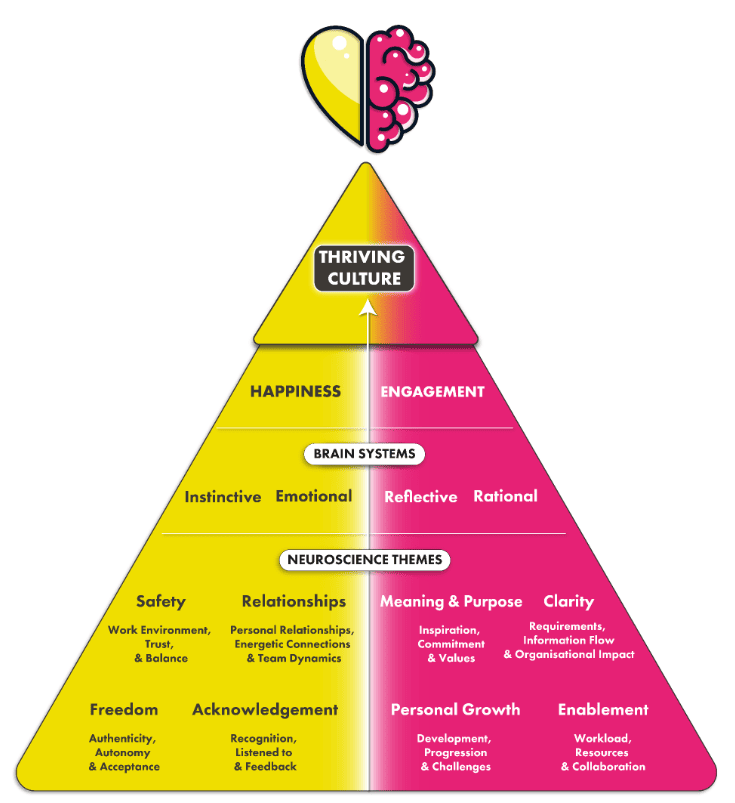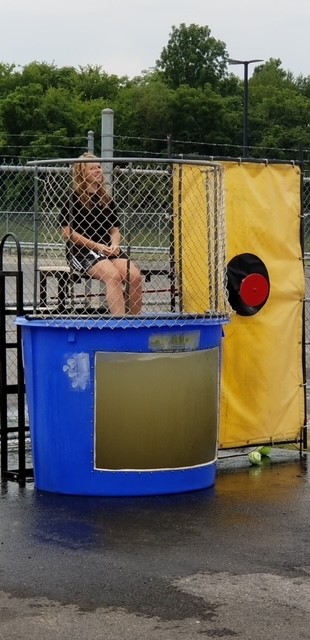Menu
Happy employees are productive employees – 13% more productive to be exact.
But in days past, keeping an employee ‘happy’ was usually intrinsically linked with the amount of money they were being paid. If their salary was good, and their performance was methodically rewarded, then this tended to spark contentment in the general worker.
However, we are now beginning to discover that making employees happy is no longer that straightforward. Matt Phelan’s recent book The Happiness Index is a testament to this, as it identifies the 24 sub-drivers of happiness and engagement at work. Yes, 24! But of these, there are some that have a stronger driving force than others; a recent survey from Wondr Health discovered that 30.1% of employees believe that building friendships was the key to fostering happiness at work, in comparison to only 12% who cited financial freedom. What’s even more interesting to note is that financial freedom ranked fourth, below physical and emotional health and wellbeing (21.5%) and engaging in activities that spark joy (16.8%).
Our own poll findings affirm this notion, as when we asked respondents what makes them feel happiest at work, 49% said it was the people they worked with, and 40% said it was the purpose their job gave them.
So, why is salary less of a concern, and what has taken its place as the key factor for fostering employee happiness?
There are two primary forces at play: the post-pandemic mindset and the flood of Gen Z into the workplace.
Since the pandemic, there has been a ‘carpe diem’ mindset emerge. After being faced with our mortality, it’s become common to use this as a point of reflection and determine what we really want to do and achieve with our time. This has driven a major shift in focus towards wellbeing, physical and mental health, and work-life balance. A report from Hays confirms this, as it revealed more than half (56%) of employees are willing to accept a lower-paid job in exchange for a better work-life balance.
What’s working in conjunction with this shift is the fact that Gen Z are now embedded into the workplace, with 27% of the workforce expected to be made up of these younger workers in 2025. With this influx of young talent also comes new ideals and values; Gen Z are the first generation to be socialised in a world with the internet readily available, and so it is no wonder that what they value and expect from work has evolved. For example, 77% of Gen Zers only want to work for a company whose values align with their own. They are more eco-conscious, they don’t shy away from previously taboo topics such as mental health, and they are notably the most diverse workforce in history.
As employers look to attracting new young talent into their businesses, they need to consider that a decent salary – whilst important – is not enough on its own to foster happiness and contentment amongst employees. Instead, salary is playing second (or maybe even third) fiddle to the rising importance of work-life balance and wellbeing support. If you would like to discuss how we can help you implement these changes into your talent attraction strategy, please get in touch with us.
Matt Phelan’s new book – The Happiness Index – is released today … and we’ve been lucky enough to get a sneak preview of what we think is a ‘must read’ for HR practitioners and business leaders.
As the co-founder of a unique platform which helps organisations measure key employee engagement and happiness drivers (also called The Happiness Index!), Matt is a global authority on how people think, feel, and behave in the workplace.
In his book, he sets out to explore how businesses can ensure that the people who fuel the success of their business – their employees – are fully committed to their organizational goals.
To do this he takes a deep dive into the data gathered by The Happiness Index platform from over 100 countries and 2 million employees to help the reader understand what really drives engagement and happiness at work – and how this can be harnessed to accelerate an organization’s performance.
Matt defines employee engagement as what our brains need to thrive at work, and employee happiness as what our hearts need to do the same. Both, he argues, are equally important and consist of 24 neuroscience-based sub-drivers:

By taking this scientific, data-driven approach, the book provides a robust examination of the factors that determine employee engagement and happiness at work, including in-depth interviews with specialists in each of the 24 sub-drivers and compelling case studies from organizations around the world. In doing so, it shows how firms can weave happiness and engagement into the fabric of their people strategy.
In The Happiness Index, Matt expertly paints a picture of a world of work where people can truly thrive and grow – and organizations can truly prosper from that growth. It’s a transformational picture we know HR practitioners and business leaders will find inspiring.
If you would like to discuss engagement strategies in more detail, please get in touch with us on our contact page.
And to get in touch with Matt, head over to his LinkedIn page: https://www.linkedin.com/in/matthewphelan/
Companies who make a point to support and work with charities are not only contributing positively to the wider community, but are also making a smart business move.
It was discovered that those businesses that donate over 0.5% of turnover were twice as likely to report enhancements in company reputation, and were nearly 50% more likely to see it help recruit and retain staff. This is all without mentioning the interpersonal benefits that doing charity work offers employees; it promotes collaboration and cohesion, and helps to break down social barriers by offering employees something to talk about and bond over that isn’t work-related.
Adopting this corporate social responsibility mindset is a great way of enriching the Social element of your ESG agenda (and it can also touch into your Environmental strategies depending on the charities employers opt to support!). However, in order to reap these benefits, employers must understand the best ways to actually engage their teams with their chosen charitable cause.
How can employers do this?
Firstly, getting employees involved in actually choosing the charities that the company should support. If the cause that the employer wants to support aligns with the mission and values of said company, as well as aligning with the values of the team, then this will immediately foster excitement and engagement. This could take shape as potentially supporting a charity for a cause that has personally touched a member or multiple members of staff. Either way, figuring out the mission is the first step to deciding what direction to go in, and encouraging employees to get involved with that will really bolster their enthusiasm!
Equally, when recruiting and onboarding new team members, it is great to highlight that charity is a value that the employer holds dear. This can be demonstrated by having a set number of volunteer days in their benefit package, which carves out dedicated time for the employee to volunteer while still being compensated. As well as this, getting them involved in a charitable project in the first few weeks of onboarding can double-down as a great ice-breaking and assimilation tool.
And, importantly, find ways to make it fun! Collaborate with the charities that you choose to work with and find out by what means they typically raise funds. If they do charity runs like Race For Life or fun challenges like growing a mustache for Movember. Whatever they do, make an effort to sponsor some (or all!) of your team to take part so that they can be actively engaged and have a change of scenery from the workplace.
This can even be taken one step further and managers can organize fundraisers of their own that are more tailored towards their staff. As you’ll see below, I was once at the mercy of a dunking booth!

But there are so many innovative ways to make giving back enjoyable for staff (although, humiliation of managers seems to be a fan-favorite from my experience). Knowing how to successfully engage your teams with fundraising and volunteer work will give you access to all the business benefits that come with it – all while doing a little bit of good for the world.
If you would like to discuss how we can support you in engaging with charities and philanthropy, please get in touch with me at Brittany@orgshakers.com
One of HR’s key functions for employers is implementing strategies to optimize productivity in the workplace.
By now, most employers will know the basics on how to go about this – but there are a growing number of innovative productivity strategies that organizations may not have considered before. They may sound counter-intuitive, but hear us out!
1. Napping on the job
Yes, you heard that right. Napping at work can be a great way of boosting productivity. Humans were originally biphasic (we slept twice a day) but now we have become monophasic (we sleep once a day), but biologically our bodies have a dip in the middle of the day where body temperature decreases, and cognitive processes are not as strong. Having a nap during this time can help improve one’s mood, engagement levels and productivity!
2. Microbreaks
Having been proven to improve engagement and productivity levels, microbreaks are when an employee takes a five-minute break between tasks and actively takes a moment for themselves. Normalizing this idea and encouraging employees to do this can have a noticeable effect on their productivity levels, as their brains are being suitably rested to keep them working at their optimum.
3. Listening to music…
The link between music and productivity continues to be investigated, but one thing that psychologists have confirmed is that music that someone likes can cause the brain to produce dopamine. This stimulates the prefrontal cortex which is responsible for planning, organizing, inhibition control, and attention. Therefore, a lot of people find that they are better able to focus and be more productive when listening to the right music (this being music that they enjoy on an individual level, so hand out some headphones!).
4. …or playing music!
What is an even more interesting way of boosting productivity is encouraging staff to actually play instruments. Neuroscientists have discovered that when a person plays an instrument, multiple areas of the brain light up and are simultaneously processing different information in intricate, interrelated, and fast sequences. This way of thinking can be translated into other areas, meaning that the individual will be able to engage more of their brain when working.
5. Pets at work
Studies have shown that when people interacted with dogs, their ability to think, plan, and concentrate was enhanced. And even more interesting to note was that this effect lasted up to six-weeks after contact. This is why many employers are now considering pet-friendly policies as a means of attracting talent and boosting productivity levels.
Crafting a working environment in creative and innovative ways can reap unexpected benefits. Even though taking your dog to work or taking a nap in the middle of day sounds like a productivity nightmare, these things – when done properly – can actually make all the difference to a team’s productivity levels. If you would like to discuss how we can help you find the best productivity strategies for your organization, please get in touch with us!
